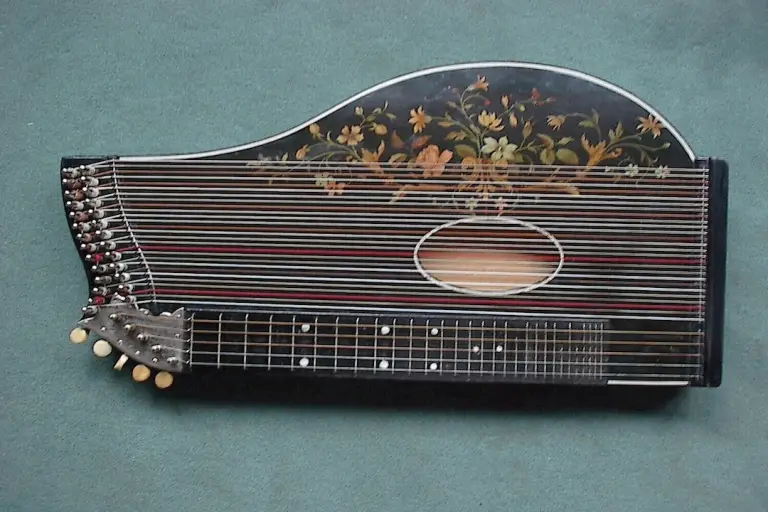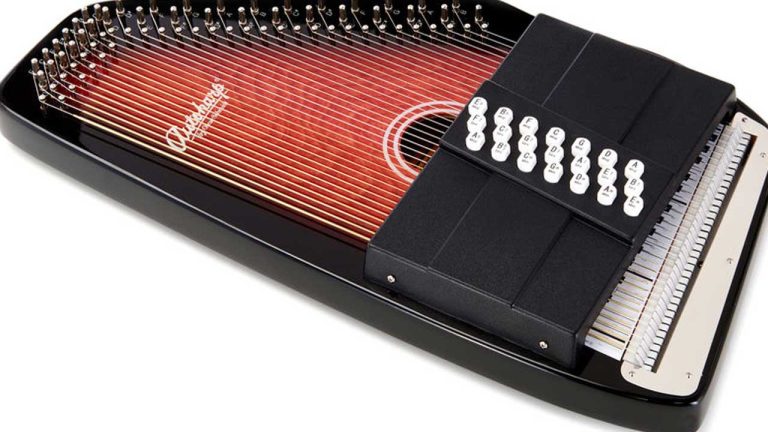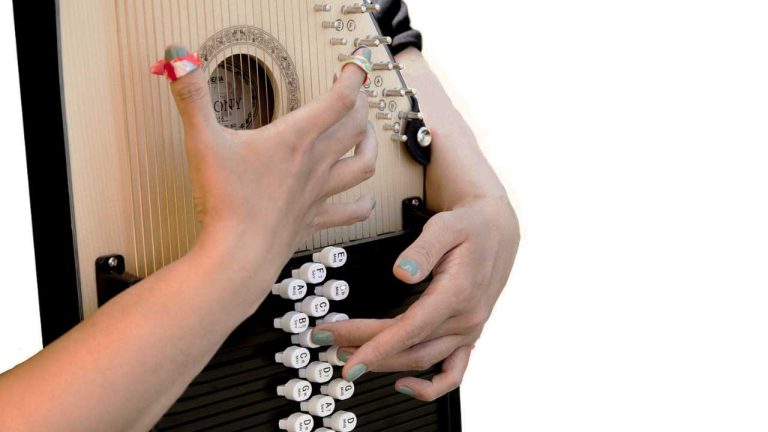Are Autoharp and Zither the Same Thing? Unraveling String Instrument Myths
Folkstrings.com is reader-supported. When you buy through links on our site, we may earn a small commission.
The autoharp and the zither are often grouped together because they are both part of the zither family. However, these instruments differ significantly in design, playing technique, and musical role.
As a musician fascinated by the rich diversity of musical instruments, I’ve explored the particulars that distinguish the autoharp and zither.
Both have strings stretched over a resonating body, but the autoharp includes a series of chord bars fitted with dampers. When pressed, these bars mute all the strings other than those that form a specific chord. This feature means that, with a simple push of a button, the player can accompany themselves harmonically.
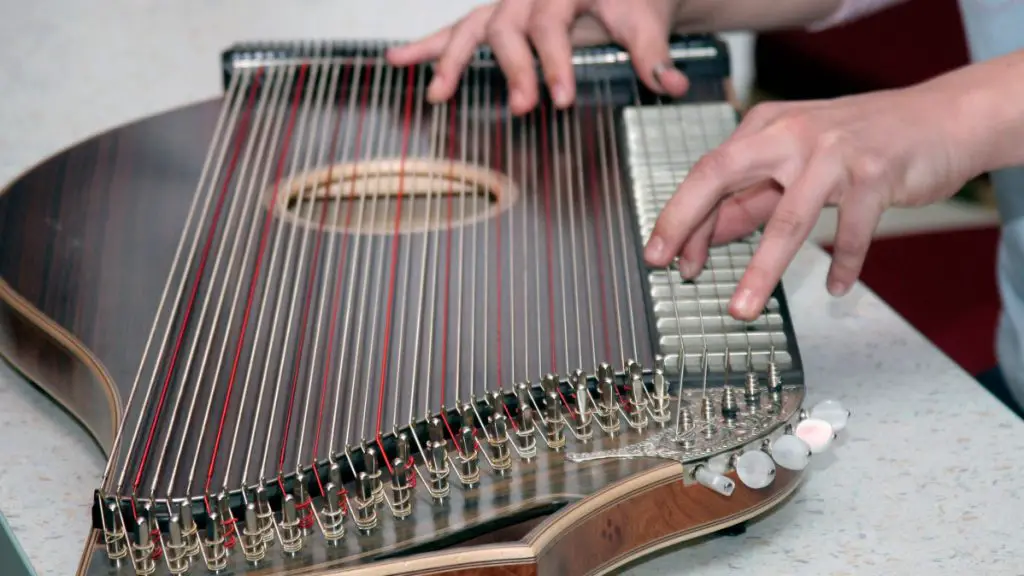
Zithers, on the other hand, do not generally have these chord bars and require players to manually stop the strings to produce the desired harmony.
The zither is a more open-ended instrument in terms of playing technique because it demands a more involved approach to creating chords and melodies, often relying on finger picking or a plectrum.
While autoharps are associated with folk and traditional music, largely from an American context, zithers have a broader range as they are found in various musical traditions across central Europe and Asia.
Key Points
- The autoharp features chord bars that allow for easy chordal accompaniment, distinguishing it from the zither.
- Zithers require a more hands-on approach to create melodies and chords, reflecting a more traditional playing technique.
- While autoharps are typically linked to American folk music, zithers have a presence in various cultural musical genres globally.
Table of Contents
Historical Context and Origins
In exploring the rich tapestry of stringed instruments, I find it fascinating to consider the distinct yet interlinked histories of the autoharp and zither. Both share a European genesis but have evolved independently.
Evolution of the Zither
The zither has its origins in Central Europe, with a strong presence in Germany and Austria. As a folk instrument, the typical zither is composed of multiple strings stretched across a flat body.
Historically, Germany stands out as a pivotal region for the development and popularity of the zither. It’s intriguing to note how these instruments have been adapted over time, with various forms emerging to suit different musical expressions.
Autoharp Innovation
Charles F. Zimmermann, a German immigrant to the United States, initially patented the autoharp in 1882. His innovative mindset led to the creation of an instrument that, while zither-like in appearance, had a unique mechanism for playing chords.
Zimmermann’s autoharp became a trademark, and he worked diligently on its development. Over time, the autoharp specifically gained a foothold in American folk music, distinct from its European zither cousins. This innovation is a testament to how cultural exchange can amplify the evolution of musical instruments.
Design and Construction
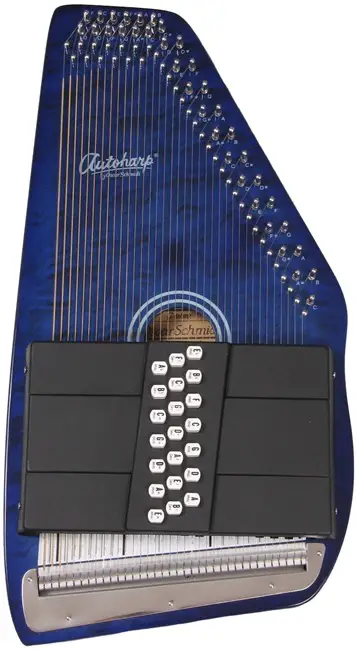
When exploring the zither and autoharp, it’s crucial to understand that while both belong to the string instrument family, their design and construction reveal distinct differences in both aesthetic and functionality.
Physical Structure of Zithers
The zither encompasses a category of string instruments that typically feature a flat body and a soundboard. The strings are stretched over the soundboard and can vary in number.
I have seen zithers range from 30 to 42 strings, accommodating a chromatic range. The wood used in construction impacts the sound quality, with spruce often preferred for the soundboard due to its resonant properties. The strings lie above a fretted fingerboard, allowing for a wide variety of tunings, but it’s the absence of dampers and chord bars that distinguishes the zither from the autoharp.
- Types of wood commonly used: Spruce (soundboard), Maple or Mahogany (body)
- Number of strings: 30-42, depending on the model
- Presence of a fretted fingerboard: Yes
Mechanics of the Autoharp
In contrast, the autoharp‘s design allows for ease of chord production. Above the strings, chord bars affixed with felt mute certain strings to form chords when pressed, while others are allowed to ring openly.
My experience tuning an autoharp reveals the presence of tuning pins, usually positioned on the side of a flat body, akin to a zither’s.
However, the autoharp differentiates itself with a set of buttons that control the chord bars, enabling a chromatic sequence of chords. The soundboard is also crucial in the construction, often made of wood like spruce, to help project the sound.
The instrument’s range generally spans 36 to 37 strings, which allows me to play a variety of music genres.
Playing Techniques
When I discuss the playing techniques of the autoharp and zither, I focus on the unique approach required for each instrument. Whether it is the specific way of strumming or the precise finger placement, these nuances contribute to their distinctive sounds.
Zither Playing Style
The zither often requires me to use a combination of plucking and strumming to produce its enchanting sounds.
My fingertips or a plectrum can be used to pluck the strings, which allows for a wide range of expressions. To play melodies, I focus on single strings, much like I would on a piano, but the technique is more akin to playing a guitar where my fingers must dance across the strings with precision.
For zithers like the chorded zither, chord playing involves pressing on the appropriate strings while strumming, which can require agility and practice to master.
Autoharp and Its Versatility
The autoharp, on the other hand, is known for its straightforward playing style that appeals to both beginners and experienced players.
To play this instrument, I often use a flat pick or my thumb to strum across the strings. The autoharp has buttons that activate chord bars, simplifying the process of forming chords.
This means I can play an accompaniment with one hand by pressing down a button, while the other hand strums or plucks the strings. This technique allows for the playing of both rhythm and melodies, which can create a rich, full sound that fills the room.
Musical Genres and Cultural Impact
In exploring the rich tapestry of the autoharp and zither’s influence, I’m particularly fascinated by their roles across various musical genres and how they’ve impacted culture.
Folk Music and Beyond
The autoharp, with its ease of play by pressing buttons to form chords, allowed me to appreciate its significant role in American folk music.
It’s a staple in the genre, often played by laying it on the lap and strumming or picking. Mother Maybelle Carter of The Carter Family pioneered the use of the autoharp in country and folk music, demonstrating its versatility.
Under her deft touch, the instrument’s sweet, resonant chords became synonymous with the country music staples heard on the Grand Ole Opry.
The concert zither, while not as widely recognized as the autoharp in popular music, holds a dear spot in my heart for its evocative sound in Central European music.
It requires a more intricate technique compared to the autoharps, as players pluck the strings with their fingers, which can be quite mesmerizing.
Notable Musicians and Performances
Oscar Schmidt is a name that resonates with me as a key figure tied to the autoharp; the brand is known for producing quality folk instruments and has been a significant contributor to the autoharp’s ability to find its home in genres beyond folk music.
The reach of the autoharp has extended globally, from the twang of bluegrass in the Appalachian Mountains to the serene soundscapes of Hawaii and India.
This instrument beautifully adapts to the cultural nuances of each region’s music. It’s not just a piece of Americana but a global citizen enhancing the diversity of the world’s musical heritage.
Frequently Asked Questions
In this section, I’ll address some common curiosities regarding autoharps and zithers to clarify their distinctions and characteristics.
What’s the difference between an autoharp and a zither?
The main difference lies in their structure and playability. An autoharp typically has a series of chord bars attached to dampers that mute all strings except those that form the desired chord, making it easier to play rhythmically.
A zither, on the other hand, is a broader category of stringed instruments and does not have these chord bars, requiring each string to be individually plucked or strummed.
Can you explain how an autoharp is played compared to a zither?
To play an autoharp, I press down on a chord bar while strumming across the strings. This allows me to play chords easily. When playing a zither, I need to pick or strum the strings individually or in groups. The zither doesn’t have chord bars, so this requires more intricate finger coordination.
What are the distinctive sounds of an autoharp?
The autoharp has a rich, resonant sound with a full chordal range. This is thanks to the dampening system that allows the specific strings to vibrate. It produces a lush, full-bodied sound that is often associated with folk and traditional music.
What other instruments are closely related to the autoharp?
Instruments closely related to the autoharp include the chorded zither and the hammered dulcimer. The hammered dulcimer is played with mallets. Meanwhile, the chorded zither also uses chord bars, but typically has fewer of them compared to an autoharp.
How does an autoharp differ from a harpsichord?
Both instruments have strings and are played by pressing keys or buttons. However, an autoharp uses felt-bearing bars to form chords, whereas a harpsichord uses a system of jacks with quills. When keys are pressed, these quills pluck individual strings. This results in a sound that’s crisper and more articulate than the strummed chords of an autoharp.
What are some alternative names for an autoharp?
The autoharp is also sometimes referred to as a chorded zither or chord harp. This is due to its ability to play chords and its setup of strings without a neck. This aligns with the zither family of instruments.
Author Profile
-
Daniel Johnstone is an English writer with a love for stringed instruments from around the world.
He shares his love for these instruments through his writing for folkstrings.com, a website dedicated to all things related to folk string music.
Daniel's passion for music started at a young age, and he has since become an accomplished musician, playing guitar, cavaco, and recently, the harp.
His dedication to learning and sharing his knowledge of stringed instruments is evident in his insightful and engaging blog posts. Whether you're a seasoned musician or a beginner, Daniel's writing is sure to inspire and entertain you.
When he's not playing music or writing, you can find Daniel exploring new instruments and seeking out new sounds to share with his readers.
Latest entries
 AutoharpApril 4, 2024What Is the Autoharp Made Of: Exploring Its Materials and Craftsmanship
AutoharpApril 4, 2024What Is the Autoharp Made Of: Exploring Its Materials and Craftsmanship AutoharpApril 4, 2024Is Autoharp Easy to Play? Unveiling the Truth for Beginners
AutoharpApril 4, 2024Is Autoharp Easy to Play? Unveiling the Truth for Beginners AutoharpApril 4, 2024What Is an Autoharp Worth? Your Guide to Pricing and Value
AutoharpApril 4, 2024What Is an Autoharp Worth? Your Guide to Pricing and Value AutoharpApril 4, 2024Are Autoharp and Zither the Same Thing? Unraveling String Instrument Myths
AutoharpApril 4, 2024Are Autoharp and Zither the Same Thing? Unraveling String Instrument Myths
Affiliates:
This post may contain affiliate links that at no additional cost to you, the site may earn a small commission. We only recommend products we would use ourselves and all opinions expressed on this site are our own.
Accuracy Advice:
While we strive to provide up-to-date and accurate information, the content in this article may not reflect the most current research or medical guidelines. We encourage readers to do further research and consult with professionals for more personalized advice.
Our Recommendations:
The products and services mentioned in any of our articles are recommended based on our independent research and personal experience. We are not sponsored by any company. We aim to suggest products and services we believe are of high quality and could be beneficial to our readers.

